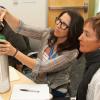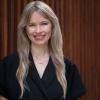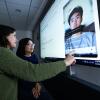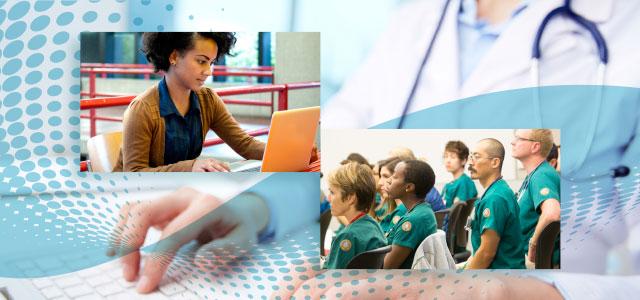
Teaching Change, Changing Teaching
In 2008, Tammy Vant Hul – an associate professor of nursing at Riverside City College, where passing rates on the NCLEX are exemplary – was speaking with a student at a clinical site. The student’s patient was scheduled for a colonoscopy but had suffered an acute heart attack 24 hours earlier. Rather than questioning whether a colonoscopy was advised, the student was trying to understand how she should proceed with medication administration prior to the procedure.
“I thought, ‘Did a red flag not go off in your mind?’ Nursing isn’t just memorization and following orders. It’s contextualized knowledge, and you have to think on your feet,” says Vant Hul. The event was one of many that prompted Vant Hul and some of her colleagues to revamp both the content and methodology of the school’s nursing program. The goal was to ensure graduates are fully prepared to not just pass a licensing exam, but also meet the real-world demands of nursing.
Vant Hul and Riverside are not alone in their concerns. Around the country, in response to the voices of policymakers and clinical nursing leaders – and in the wake of health care reform’s demands and changes in educational methods spurred by a generation of students who have grown up with smartphones – nursing schools have been examining and reshaping not just what their students learn, but how they learn it.
Understanding the Need
At UC San Francisco School of Nursing, Dean David Vlahov and Associate Dean for Academic Programs and Diversity Initiatives Judy Martin-Holland have been working with faculty to make informed choices about exactly what change is necessary and how best to implement it.
The effort crystallized in a March 2014 faculty development workshop where Vant Hul was one of the featured speakers, along with UCSF neurologist and innovative educator Daniel Lowenstein; Ann Scanlon McGinity, chief nurse executive and senior vice president of operations at Houston Methodist Hospital; and faculty from the School who have been leading some of its educational reforms.
“I wanted to make sure our entire faculty fully sees how much the landscape is changing,” says Martin-Holland, who organized the workshop. “Our students have to understand the new roles, opportunities, knowledge and skills they need in a changing system of care – and in many cases, to lead the needed changes. Our faculty has to understand how changes in our health care delivery system, mostly as a result of the Affordable Care Act implementation and the complexity of patient care, change the knowledge, skills and abilities our graduates will need. This has become increasingly clear from speaking and working with our practice partners at clinics, in public health settings and [at] many major medical centers that serve as our partners.”
In addition to concerns about students’ ability to apply their knowledge, Scanlon McGinity spoke about how the ACA’s financial incentives are shifting the educational emphasis from acute care settings to team-based care for the entire health care continuum, including transitional care and outpatient settings. Disease management, preventive care, genomics, mobile technology, interprofessional communication, systems leadership, population health and project management are among the skills now taking center stage.
“But the science and the care practices are unfolding so fast that many times faculty are not up to date, so we have to create ways for faculty to update their knowledge and for students to gain experience with top-notch mentors who are implementing these changes in real-life settings,” says Scanlon McGinity.
Equally important, adds Vlahov, “People learn differently today than they learned in the past. There’s technology. There’s the need to make education more accessible for students’ complicated lives. And there are new ways to teach that help people retain and apply learning better than traditional lecture formats.”
The “Guide on the Side” and the Flipped Classroom
The movement away from teachers acting as the “sage on the stage” to the “guide on the side” has been under way for some time in many educational settings. In nursing, this shift often translates into using class time for case studies, role-playing, simulations and critical reflection.
It also has led to the so-called flipped classroom, where students often receive what was previously lecture material online and then come to class prepared to apply their learning through any number of the above techniques.
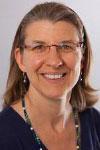 Cynthia Belew Nurse-midwife Cynthia Belew was among the first at the School to adopt the approach, back in 2006. “We were seeing the same thing [as Vant Hul],” she says. “Students could learn something in the classroom to do well on exams, but in labor and delivery or in clinic, they didn’t have a clue how to apply it.”
Cynthia Belew Nurse-midwife Cynthia Belew was among the first at the School to adopt the approach, back in 2006. “We were seeing the same thing [as Vant Hul],” she says. “Students could learn something in the classroom to do well on exams, but in labor and delivery or in clinic, they didn’t have a clue how to apply it.”
She and others in the nurse-midwifery program began to revamp their program, using research that demonstrated students learn best when they actively construct their learning and learn from their peers, but with guidance from an expert teacher who places the learning in proper context.
For example, while teaching labor dystocia (slow or difficult labor), Belew has her students research one aspect of this clinical problem from an online list of subtopics, such as fetal malpresentation or how to manage latency or the active phase. Belew selects and makes necessary readings available online. An online quiz checks for understanding. In class, Belew might unfold a case study, and the students weigh in when their particular subtopic emerges, using that time to teach their classmates what they’ve learned. They identify what they don’t know, discuss the pros and cons of various options and draw on the literature to defend their practices.
In the end, students must still pass a written exam, write papers and get assessed in their clinical rotations, but, says Belew, “What we hear from people working with them clinically is that our students are now better prepared.”
The students seem to agree. Since 2006, Belew’s students have recognized her four times with the American College of Nurse-Midwives Excellence in Teaching Award.
“With full midwifery clinical schedules, our time on campus in the classroom is really precious,” says former student Sage Bearman. “As adult learners, we are all quite experienced at sitting through a lecture and absorbing information, and we can do that at home via online content delivery and then take advantage of the opportunity to sit with our faculty and colleagues, discuss the state of the science and work through case studies and management plans. The quality of learning in the flipped-classroom format far surpasses that of traditional learning formats, especially for advanced practice clinicians in training.”
But execution matters, says Belew, who emphasizes the need to create a safe learning environment where students can make mistakes; she believes personal contact between student and teacher is essential for building the necessary trust. “It’s also more fun and satisfying for the instructor,” she adds. “Instead of giving a lecture, I’m interacting with students.”
Taking Advantage of New Tools
Different versions of the flipped classroom take advantage of a variety of new tools that were not available to a previous generation of instructors.
Abbey Alkon, who teaches a class that helps master’s students understand and apply research findings in clinical, research or administrative settings, points to the simple availability of high-quality videos. After teaching her class in a traditional lecture format for 10 years, Alkon volunteered to teach it as a massive open online course, or MOOC, using the Coursera platform. Using the high-quality video she created for the MOOC – and working in collaboration with colleague Laura Wagner – she now conducts four weeks of the class at the School as a flipped classroom. “One of our students told us she loved the video because it felt like a one-on-one lesson in her home,” says Alkon.
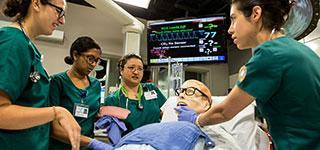 Students in the UCSF Kanbar Center for Simulation, Clinical Skills and Telemedicine Education Similarly, the advent of sophisticated simulation labs enables students of all types to gain valuable experience prior to working with live patients. Pam Bellefeuille, for example, uses the UCSF Kanbar Center for Simulation, Clinical Skills and Telemedicine Education to introduce Master’s Entry Program in Nursing students to their first clinical experience (see photo gallery).
Students in the UCSF Kanbar Center for Simulation, Clinical Skills and Telemedicine Education Similarly, the advent of sophisticated simulation labs enables students of all types to gain valuable experience prior to working with live patients. Pam Bellefeuille, for example, uses the UCSF Kanbar Center for Simulation, Clinical Skills and Telemedicine Education to introduce Master’s Entry Program in Nursing students to their first clinical experience (see photo gallery).
Lynda Mackin and Catherine Waters teach a two-part course on evidence-based project planning, which reflects the School’s efforts to adapt both curriculum and methodology to changing needs. The course emerged in response to local chief nursing officers expressing a need for graduates who can effectively conduct small tests of change for quality or performance improvement.
In the first half of the course (Part A), Mackin has begun using online learning modules in combination with periodic face-to-face meetings and WebEx videoconferencing. Developed by the Institute for Healthcare Improvement, the modules walk students through a series of steps that ensure they understand key concepts about process improvement in clinical settings.
Then, in Part B of the course, students execute a small test of change in a clinical setting, which they then discuss with the teachers and classmates. Projects at UCSF Medical Center have included efforts to improve chronic pain management, timely diabetes screening, restraint use in the ICU and discharge planning.
The course represents two concepts currently in vogue in education: mastery learning, in which students must objectively demonstrate they have mastered content before moving on to the next concept, and critical reflection, which forces students to articulate what they’ve learned and what they might do differently, given another opportunity.
Critical Reflection
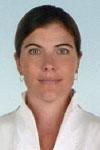 Rosalind De Lisser Rosalind De Lisser is well versed in the use of critical reflection, both oral and written, and uses it frequently in her teaching. She is a proponent of UCSF physician Louise Aronson’s LEaP (Learning from your Experiences as a Professional) model, which requires structured journaling about the clinical experience.
Rosalind De Lisser Rosalind De Lisser is well versed in the use of critical reflection, both oral and written, and uses it frequently in her teaching. She is a proponent of UCSF physician Louise Aronson’s LEaP (Learning from your Experiences as a Professional) model, which requires structured journaling about the clinical experience.
“Good critical reflection results in great clinical problem-solving skills, because it demands critical thinking – including understanding what you don’t know and where the resources exist to make better decisions – and it requires the student to examine personal history and biases, because our past experiences affect our ability to make unbiased, best-practice decisions,” says De Lisser. “If students walk into their exam rooms, and they’ve already gone through the process of examining biases and understanding where their resources are, they can approach the encounter better prepared and with more confidence.”
Overcoming the Hurdles
All of these changes and others may make sense in the abstract, but ensuring they actually achieve their goals involves leaping over numerous hurdles, which range from simple logistics to the complex psychology of change management.
Take the concept of interprofessional, team-based training. Despite the widely acknowledged need for such training, it is often very difficult to coordinate the schedules of medical students and residents with advanced practice nursing and pharmacy students.
In addition, new teaching methods and curricula can place extraordinary demands on faculty time and mental energy. “Gone are the days when I walk in with a PowerPoint that I’ve used for years,” says Vant Hul. “I have to emotionally and creatively prepare, which takes time. I have never done so much work in my life.”
Then there’s the crucial question of whether or not the work is paying off in better-prepared students. Vlahov says, “There is literature looking at online/hybrid versus traditional methods that shows equivalent comprehension and greater retention.”
Nevertheless, some instructors say, the new methods also open avenues for some of teaching’s timeless challenges.
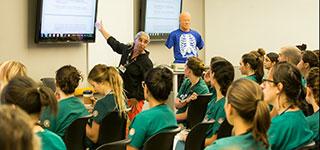 Pam Bellefeuille with students “Students seem very excited about the flipped classroom and really engaged in the content during class, but we don’t know if they learned more than the traditional format. Also, the faculty don’t know if the students watched the assigned videos before they attended the small seminar classes,” says Alkon. “I think we may need to assess their knowledge on the preassigned lecture material – maybe something as simple as a quiz when they enter class – or explore new methods to evaluate their preparation.”
Pam Bellefeuille with students “Students seem very excited about the flipped classroom and really engaged in the content during class, but we don’t know if they learned more than the traditional format. Also, the faculty don’t know if the students watched the assigned videos before they attended the small seminar classes,” says Alkon. “I think we may need to assess their knowledge on the preassigned lecture material – maybe something as simple as a quiz when they enter class – or explore new methods to evaluate their preparation.”
Finally, even if the logistical and bureaucratic hurdles prove manageable and the methods show improvement over traditional classes, cultural and institutional change is hard. Faculty members are often very tied to methods and curricula they’ve dedicated their careers to developing. Similarly, students often have a particular set of expectations when they apply to a school, especially one with UCSF’s reputation.
“Online education is very controversial here,” says Martin-Holland. “Students come here wanting face-to-face interactions with the faculty; they want a high-touch environment. Having said this, students also have indicated to us they enjoy and find their learning enhanced by using several of the flipped-classroom techniques employed by many of our faculty. The right mix for us seems to be to use a variety of learning strategies that engage students in active learning, while preserving face-to-face learning environments in which students connect with our faculty. Students see our faculty as role models, experts and facilitators of their learning.”
For faculty, Vlahov says it’s essential to provide institutional support for their efforts to evaluate and implement change – and to understand this is an ongoing process.
“It’s not fair to ask faculty content experts – who already have busy teaching loads – to also be advanced instructional designers and programmers,” says Vlahov. “We need to bring in outside expertise where necessary and be deliberate in our choices. We can’t do everything all at once. That’s why in speaking with both faculty and students, it’s important to be clear about the vision and mindful of the support services that are needed. We know some faculty who are early adopters become faculty champions, such as Annette Carley, who has taken a lead in helping to coordinate School faculty with other UCSF resources to accelerate adoption of new modes of educational delivery. Others are drawn back towards what’s comfortable. In change management, there is always that uncomfortable stage where both groups exist in nearly equal numbers; we’re trying to find the proper balance.”

